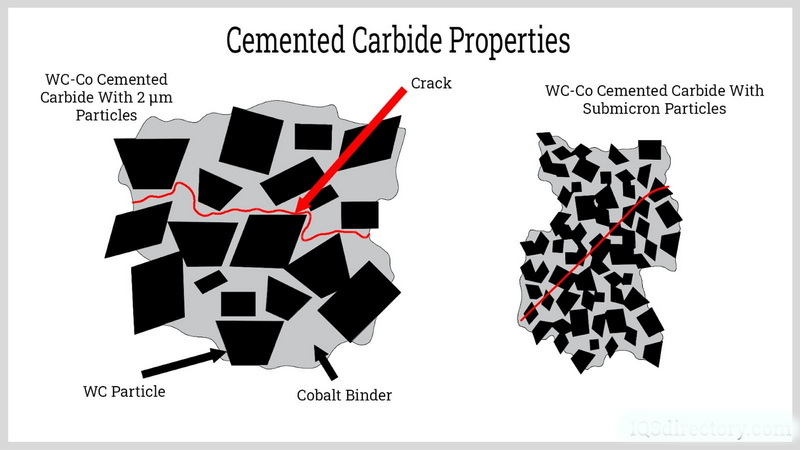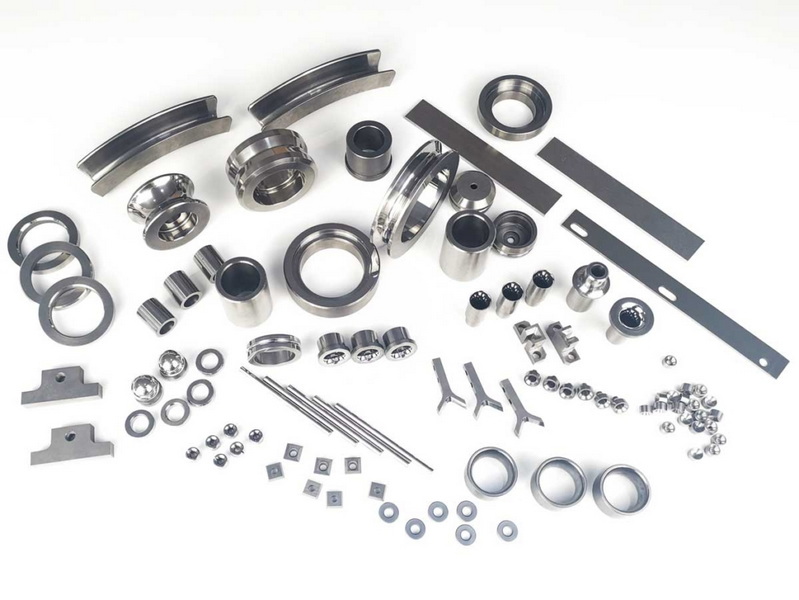Content Menu
● Introduction to Tungsten Carbide
● Properties of Tungsten Carbide
● Applications of Tungsten Carbide
● Factors Contributing to Cracking in Tungsten Carbide
>> Thermal Stress
>> Mechanical Stress
>> Material Defects
>> Corrosion
>> Fatigue
● Crack Propagation in Tungsten Carbide
● Measures to Control and Prevent Cracking
>> Material Selection
>> Design Optimization
>> Surface Treatment
>> Process Control
>> Operating Conditions
● Conclusion
● FAQ
>> 1. Is tungsten carbide brittle?
>> 2. Can tungsten carbide be welded?
>> 3. How does temperature affect tungsten carbide?
>> 4. What is the typical lifespan of tungsten carbide components?
>> 5. Can cracked tungsten carbide be repaired?
● Citations:
Tungsten carbide is celebrated for its exceptional hardness, wear resistance, and high melting point, making it a cornerstone material in diverse industries. From cutting tools that shape the world around us to wear parts that endure relentless abrasion, tungsten carbide stands as a testament to human ingenuity. However, like any material subjected to the rigors of real-world applications, it is susceptible to cracking under specific conditions. This article delves into the intricacies of cracking in tungsten carbide, exploring the factors that contribute to its occurrence, examining its applications, and outlining measures to prevent crack propagation, ensuring the longevity and reliability of components made from this remarkable material.

Introduction to Tungsten Carbide
Tungsten carbide (WC) is a chemical compound consisting of equal parts of tungsten and carbon atoms. It exists as a hard, brittle material characterized by a high melting point (2,870 °C) and exceptional wear resistance. Tungsten carbide is commonly employed in the form of cemented carbides, where WC grains are bonded together by a metallic binder, typically cobalt. This synergistic combination yields a material with high hardness, strength, and toughness, making it eminently suitable for demanding applications across a spectrum of industries.
Properties of Tungsten Carbide
Tungsten carbide possesses a unique confluence of properties that render it indispensable for a wide array of applications:
- High Hardness: Tungsten carbide reigns supreme on the Mohs scale of hardness, typically registering between 9.0 and 9.5, thereby cementing its position as one of the hardest materials known to mankind.
- Wear Resistance: It exhibits unparalleled resistance to abrasion, erosion, and other forms of wear, ensuring a prolonged service life even in the most punishing environments.
- High Melting Point: With a melting point soaring to 2,870 °C, tungsten carbide can withstand extreme temperatures without succumbing to deformation or loss of strength, thereby enabling its use in high-temperature applications.
- Compressive Strength: Tungsten carbide boasts exceptional compressive strength, enabling it to endure substantial loads without undergoing deformation or structural failure.
- Thermal Conductivity: It possesses commendable thermal conductivity, facilitating efficient heat dissipation in high-temperature applications, thus preventing overheating and thermal damage.
- Chemical Inertness: Tungsten carbide exhibits remarkable resistance to a wide spectrum of chemical reactions, rendering it suitable for deployment in corrosive environments where other materials would quickly degrade.
Applications of Tungsten Carbide
Tungsten carbide finds extensive application across a myriad of industries, owing to its exceptional properties and versatility:
- Cutting Tools: It is extensively employed in cutting tools for machining, drilling, and milling operations, where its hardness and wear resistance ensure efficient material removal and prolonged tool life, thereby boosting productivity and reducing downtime.
- Wear Parts: Tungsten carbide components are indispensable in applications demanding high wear resistance, such as nozzles, bearings, and dies, where they withstand constant abrasion and erosion, ensuring reliable performance and extended service life.
- Drilling and Mining: It is utilized in drill bits and other tools for boring through formidable materials such as rock and concrete, enabling efficient excavation and resource extraction in the mining and construction industries.
- Automotive: Tungsten carbide finds application in engine parts, turbochargers, and braking systems, where its wear resistance and high-temperature strength contribute to enhanced performance, durability, and fuel efficiency.
- Medical: It is utilized in surgical instruments, radiation shielding, and implants, owing to its durability, corrosion resistance, and biocompatibility, ensuring the safety and efficacy of medical procedures and devices.
- Jewelry: Tungsten carbide's hardness and scratch resistance make it a popular material for rings and other jewelry items, offering enduring beauty and resistance to everyday wear and tear.
- Aerospace: It is used in the aerospace industry for components requiring high strength and wear resistance, ensuring the reliability and safety of aircraft and spacecraft operating in extreme conditions.
- Construction: Tungsten carbide is commonly used in construction materials such as saws and drill bits because it is almost unbreakable, allowing workers to perform difficult jobs without damaging their tools.

Factors Contributing to Cracking in Tungsten Carbide
Despite its exceptional properties, tungsten carbide is not immune to cracking under certain circumstances. Several factors can contribute to the initiation and propagation of cracks in this material:
Thermal Stress
Tungsten carbide roll rings are vulnerable to hot cracks during hot rolling processes. The propagation of these hot cracks depends not only on the cooling effect but also on the properties of the rolled material. During hot rolling, the surface temperature of the roll ring escalates due to contact with the hot-rolled piece, causing the surface metal to expand, while the metal in the deeper layers experiences a smaller temperature increase. This temperature gradient engenders compressive stress on the surface. Conversely, when the surface of the roll ring is quenched by cooling water, the surface metal contracts, inducing tensile stress. The repeated alternation between thermal stress and cooling can cause heat fatigue cracks and micro-cracks at the bottom of the roll ring groove.
Mechanical Stress
High mechanical loads or impact forces can initiate cracks in tungsten carbide components. These stresses may arise from machining operations, service loads, or accidental impacts. The presence of stress concentrations, such as sharp corners or notches, can exacerbate crack initiation. Sudden impacts or excessive pressure can create stress fractures, leading to cracks that compromise the structural integrity of the material.
Material Defects
Inhomogeneities, porosity, or inclusions within the tungsten carbide material can act as crack initiation sites. These defects may arise during the manufacturing process and weaken the material's resistance to cracking. Voids, impurities, or uneven distribution of the binder phase can create weak points within the material, making it more susceptible to crack formation.
Corrosion
Corrosive environments can promote crack initiation and propagation in tungsten carbide. Chemical attack on the material surface can create surface defects, which act as stress concentrators and facilitate crack growth. Exposure to acids, alkalis, or other corrosive substances can lead to surface degradation, weakening the material and increasing its susceptibility to cracking.
Fatigue
Cyclic loading can lead to fatigue cracking in tungsten carbide components. Repeated application of stress, even at levels below the material's tensile strength, can cause microscopic cracks to form and gradually grow over time. Over time, these micro-cracks can coalesce and propagate, eventually leading to catastrophic failure of the component.
Crack Propagation in Tungsten Carbide
Crack propagation in tungsten carbide entails the extension of existing cracks through the material. The rate of crack propagation depends on several factors, including the applied stress, material microstructure, and environmental conditions. Generally, crack propagation in tungsten carbide is brittle, implying that cracks tend to grow rapidly and catastrophically without significant plastic deformation. The absence of significant plastic deformation means that cracks propagate quickly and unpredictably, leading to sudden failure of the component.
Measures to Control and Prevent Cracking
Several measures can be implemented to control and prevent cracking in tungsten carbide components, thereby enhancing their reliability and longevity:
Material Selection
Selecting the appropriate grade of tungsten carbide for a specific application is paramount. Factors to consider include the binder content, grain size, and hardness of the material. For applications involving high stress or impact, opting for a grade with higher toughness and fracture resistance is imperative. The choice of binder material, such as cobalt, nickel, or iron, can also influence the material's resistance to cracking.
Design Optimization
Designing components with smooth transitions, generous radii, and minimal stress concentrations can substantially reduce the risk of crack initiation. Avoiding sharp corners, notches, and other geometric features that can act as stress risers is essential. Rounded edges and gradual transitions in geometry can help distribute stress more evenly, minimizing the likelihood of crack formation.
Surface Treatment
Applying compressive residual stresses to the surface of tungsten carbide components can bolster their resistance to cracking. Surface treatments such as shot peening or laser peening can introduce compressive stresses that counteract tensile stresses and inhibit crack growth. These treatments create a surface layer that is more resistant to crack initiation and propagation.
Process Control
Meticulous control of manufacturing processes, such as sintering and machining, can minimize the introduction of material defects. Ensuring uniform density, minimizing porosity, and averting surface damage during machining are essential for preventing crack initiation. Careful attention to process parameters such as temperature, pressure, and cooling rates can help minimize the formation of defects and ensure consistent material quality.
Operating Conditions
Avoiding excessive loads, impacts, and thermal stresses during service can prolong the lifespan of tungsten carbide components. Implementing proper cooling techniques, lubrication, and maintenance practices can also curtail the risk of cracking. Regular inspection and maintenance can help identify and address potential issues before they escalate into critical failures.
Conclusion
Tungsten carbide, with its remarkable properties and versatility, remains a cornerstone material in various industries. While it boasts exceptional hardness and wear resistance, it is not immune to cracking under certain conditions. By understanding the factors that contribute to cracking, such as thermal stress, mechanical stress, material defects, corrosion, and fatigue, and implementing measures to control and prevent crack propagation, engineers and manufacturers can ensure the longevity and reliability of tungsten carbide components. Careful material selection, design optimization, surface treatment, process control, and adherence to proper operating conditions are crucial for mitigating the risk of cracking and maximizing the performance of tungsten carbide in demanding applications. As technology advances and new applications emerge, continuous research and development efforts will further enhance the understanding and utilization of tungsten carbide, solidifying its position as a material of choice for critical components across a wide spectrum of industries.

FAQ
1. Is tungsten carbide brittle?
Yes, tungsten carbide is generally considered a brittle material, which means it has a tendency to fracture or crack rather than deform plastically under stress. This brittleness is one of the factors that can contribute to its susceptibility to cracking.
2. Can tungsten carbide be welded?
Welding tungsten carbide is a complex process due to its high melting point and brittleness. Special welding techniques, such as laser welding or brazing, can be used to join tungsten carbide to other materials, but the resulting joint may still be susceptible to cracking.
3. How does temperature affect tungsten carbide?
Tungsten carbide retains its hardness and strength at high temperatures, making it suitable for high-temperature applications. However, rapid temperature changes or thermal cycling can induce thermal stresses, which may lead to cracking, especially if the material is not properly designed or manufactured.
4. What is the typical lifespan of tungsten carbide components?
The lifespan of tungsten carbide components varies depending on the application, operating conditions, and material quality. With proper care and maintenance, tungsten carbide components can last for many years, even in demanding environments. However, factors such as excessive stress, corrosion, or fatigue can shorten their lifespan.
5. Can cracked tungsten carbide be repaired?
Repairing cracked tungsten carbide is often challenging due to its brittleness and high melting point. In some cases, cracks can be repaired by brazing or using specialized adhesives, but the repaired component may not have the same strength or performance as the original. In many cases, replacing the cracked component is the most reliable solution.
Citations:
[1] https://www.maxcarbide.com/info-detail/what-are-the-reasons-for-the-cracks-of-the-tungsten-carbide-roll-rings
[2] https://en.wikipedia.org/wiki/Tungsten_carbide
[3] https://www.samaterials.com/content/application-of-tungsten-in-modern-industry.html
[4] https://carbideprocessors.com/pages/carbide-parts/crack-propogation.html
[5] https://www.itia.info/properties-intermediates/
[6] https://eurobalt.net/blog/2022/03/28/all-the-applications-of-tungsten-carbide/
[7] https://generalcarbide.com/pdf/General-Carbide-Designers-Guide-Tungsten-Carbide.pdf
[8] http://www.tungsten-carbide.com.cn
[9] https://www.tungco.com/insights/blog/5-tungsten-carbide-applications/
[10] https://www.carbide-usa.com/top-5-uses-for-tungsten-carbide/
















